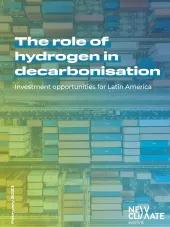This report examines the potential role of multilateral development banks (MDBs) in ensuring that Global South producer countries secure sustainable development benefits from green hydrogen development.
Green hydrogen and development finance
The analysis is founded on a dual rationale. First, it recognises that green hydrogen presents both opportunities and risks for the sustainable development of Global South countries investing in its production. On the one hand, green hydrogen can lead to desirable outcomes like industrial development, job creation, and domestic decarbonisation. On the other hand, it could create or exacerbate extractive trade relations, debt burdens, and land and water stress.
Second, it asserts that MDBs have the mandate to shape their engagement in Global South countries in a way that delivers positive sustainable development outcomes for producer countries. As development banks, it is their role to champion sustainable development for producer countries in the emerging market and policy landscape for green hydrogen. It is also their role to set the right example for lending practices at an early stage, moving beyond the “do no harm” principle and prioritising value addition.
Analytical framework and case studies
In our report, we conducted a three-step analysis. First, we examined the theoretical conditions under which green hydrogen would have desirable or undesirable impacts on nine aspects of sustainable development. The conditions for positive or negative impacts are summarised in the Sustainable Development Impact Matrix.
Second, we selected instruments from the MDB climate finance and strategy toolkit that have the potential to influence sustainable development and formulated recommendations on how they can be used to secure the desirable impacts presented in the Sustainable Development Impact Matrix. The recommendations are summarised in Summary of recommendations across the MDB climate finance and strategy toolkit.
The recommendations reflect several key high-level principles for MDB engagement, including setting high eligibility standards for projects receiving MDB support, supporting comprehensive national hydrogen strategies and regulatory frameworks in borrower countries reflecting domestic development priorities, using financial and technical support tools complementarily to leverage their synergistic effects, and fostering cooperation among MDBs to maximise impact and avoid duplication of efforts.
Using the analytical framework we developed, we assessed four cases of development financing support for green hydrogen – the African Development Bank in Namibia, the World Bank in India, the European Investment Bank’s Green Hydrogen Fund, and Team Europe’s H2Global Instrument. We analysed the impact conditions in each case to identify the opportunities and risks.
Key messages
Market forces alone are insufficient to guarantee that green hydrogen production yields sustainable development outcomes for local communities and producing countries. As calls to increase green hydrogen production grow, MDBs must consider, in parallel, their role in enabling sustainable development. This report seeks to contribute to the narrative on green hydrogen production by highlighting the enabling conditions required to foster positive sustainable development impacts for producer countries in the Global South.









